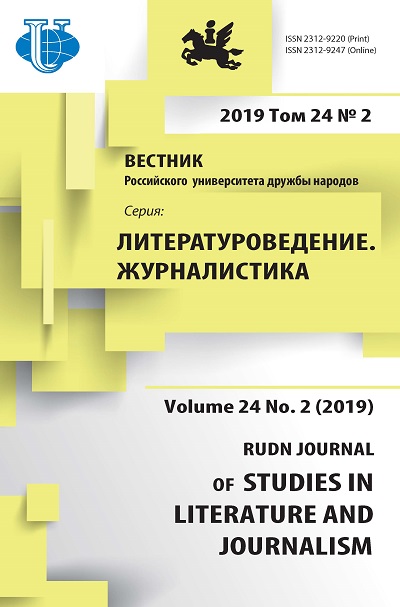Christian motives in the tale of people’s militia in 1611-1612 in the New Chronicler
- Authors: Tufanova O.A.1
-
Affiliations:
- A.M. Gorky Institute of World Literature of the Russian Academy of Sciences
- Issue: Vol 24, No 2 (2019)
- Pages: 171-178
- Section: LITERARY CRITICISM
- URL: https://journals.rudn.ru/literary-criticism/article/view/21725
- DOI: https://doi.org/10.22363/2312-9220-2019-24-2-171-178
- ID: 21725
Cite item
Full Text
Abstract
The idea of cleansing the Moscow state, closely related to the idea of protecting the true Orthodox faith permeates the tale of people’s militia in 1611-1612 in the New Chronicler. The specifics of the story about the events of 1611-1612, observed in the New Chronicler, which found expression in a combination of motives, reflecting real actions of militia organizing, and motives of hoping for God’s help and with God’s help and miracle workers indicates that relatively recent past is quite deliberately transformed by the author into the system-constructed text, in which all elements are subject to two main ideas. It is not by chance that in the militia organizers personalities in 1611-1612 the author of the New Chronicler emphasizes exclusively the qualities that characterize them as people who deeply believe and act in the difficult events of The Time of Troubles in accordance with the basics and rules of Orthodox culture. In general, the New Chronicler reflected in the story about events in 1611-1612, established by the 30th years of the 17th century the events interpretation, turning the history of the people’s militia in the symbolic “sign”: victory was possible thanks to the “admonition” of the people, the return of the “fallen people” to the Orthodox fundamentals of good behavior, which was consecrated by the God’s help and miracle workers.
About the authors
Olga A. Tufanova
A.M. Gorky Institute of World Literature of the Russian Academy of Sciences
Author for correspondence.
Email: tufoa@mail.ru
PhD, Senior Researcher, A.M. Gorky Institute of World Literature of the Russian Academy of Sciences
25A Povarskaya St., Moscow, 121069, Russian FederationReferences
- Adrianova-Peretts V.P. “Smutnoe vremya” v izobrazhenii literaturnykh pamyatnikov 1612—1630 gg. [“Time of Troubles” in the depiction of Old Russian literature’s texts of 1612—1630]. In: Orlova A.S., Adrianovoi-Peretts V.P., Gudziya N.K. (eds). Istoriya russkoi literatury [History of Russian literature]. Vol. 2. Part 2: Literatura 1590—1690 gg. Moscow; Leningrad, AN SSSR Publ., 1948. Pр. 45—77.
- Vovina V.G. Novyi letopisets i spornye voprosy izucheniya pozdnego russkogo letopisaniya [New chronicler and controversial issues of studying the late Russian chronicling]. Otechestvennaya istoriya. 1992. No. 5. Pp. 117—130.
- Demin A.S. Drevnerusskaya literatura kak literatura (O manerakh povestvovaniya i izobrazheniya) [Old Russian literature as literature (About manners of narration and image)] / ed. by V.P. Grebenyuk. Moscow, Yazyki slavyanskoi kul’tury Publ., 2015. 488 p.
- Iz Khronografa 1617 goda [From the Chronograph of 1617]. In: Dmitriev L., Likhachev D. (eds). Pamyatniki literatury Drevnei Rusi: Konets XVI — nachalo XVII vekov [Old Russian literature: late 16th — early 17th centuries]. Moscow, Khudozh. lit. Publ., 1987. Pp. 318—357.
- Kuskov V.V. Istoriya drevnerusskoi literatury [The history of Old Russian literature]. 5th ed. Moscow, Vysshaya shkola Publ., 1989. 304 p.
- Lur’e Ya.S. Obshcherusskie letopisi XIV—XV vv. [All-Russian Chronicles of the 14th—15th centuries]. Leningrad, Nauka Publ., 1976. 283 p.
- Novyi letopisets, sostavlennyi v tsarstvovanie Mikhaila Fedorovicha, izdan po spisku knyazya Obolenskogo [The New Chronicler, compiled in the reign of Mikhail Fedorovich, was published according to the list of Prince Obolensky]. Moscow, V Universitetskoi tip. Publ., 1855. 190 p.
- Solodkin Ya.G. Letopisets Novyi [Chronicler New]. Slovar’ knizhnikov i knizhnosti Drevnei Rusi [Dictionary of scribes and scribbling of Old Russia]. Issue 3 (XVII v.). Part 2 (I—O). Saint Petersburg, Dmitrii Bulanin Publ., 1993. Pp. 257—263.
- Uspenskii B.A. Izbrannye Trudy [Selected Works]. Ch. I. Semiotika istorii. Semiotika kul’tury [Vol. I. The Semiotics of History. Semiotics culture]. Moscow, Gnozis Publ., 1994. 432 p.
Supplementary files















